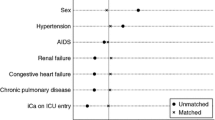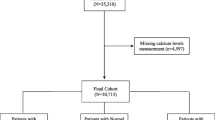Abstract
Background Hypocalcemia is common in patients admitted to the surgical intensive care unit and is associated with increased morbidity and mortality. Current dosing strategies do not always achieve ionized calcium (iCa) normalization, especially in patients with severe hypocalcemia. Objective The purpose of this study was to explore the association between intravenous (IV) calcium dose and change in ionized calcium. Setting Patients admitted to the surgical intensive care unit with concomitant hypocalcemia at a large academic hospital in the United States. Method This single center, retrospective cohort study evaluated the association between IV calcium dose and subsequent change in ionized calcium level in adult surgical intensive care unit patients with hypocalcemia. The primary outcome of this study was to develop a model exploring the association between IV calcium dose and change in iCa levels. Secondary outcomes included describing the average IV calcium dose required to normalize iCa levels, average time to normalization of iCa levels, and assessing the safety of IV calcium replacement. Main outcome measure Change in iCa. Results One hundred and ninety-four patients met study criteria. In the final model initial iCa level, total calcium dose, the interaction between initial iCa level and total calcium dose, age, and pancreatitis remained. The model (R2 = 0.625) is expressed by the following equation: Change in iCa level = 0.462 − 0.011 × [Ca dose] − 0.0007 × [Age] − 0.259 × [Initial iCa] + 0.076 × [initial iCa × Ca dose] − 0.076 × [Pancreatitis]. Removing two patients that received > 10 grams of total calcium improved the R2 to 0.769. Lastly, a simplified model removing age and pancreatitis found a similar R2 of 0.756. Conclusion We observed that change in iCa level after initial calcium dose depended on the baseline iCa. Our full and simplified model excluding two outliers predicted 76.9% and 75.6% of the variation in iCa response, respectively. If validated in other settings this model could be utilized to provide more accurate calcium dosing.

Similar content being viewed by others
References
Zivin JR, Gooley T, Zager RA, Ryan MJ. Hypocalcemia: a pervasive metabolic abnormality in the critically ill. Am J Kidney Dis. 2001;37:689–98.
Zaloga GP. Hypocalcemia in critically ill patients. Crit Care Med. 1992;20:251–62.
Chernow B, Zaloga G, McFadden E, Clapper M, Kotler M, Barton M, et al. Hypocalcemia in critically ill patients. Crit Care Med. 1982;10:848–51.
Desai TK, Carlson RW, Geheb MA. Prevalence and clinical implications of hypocalcemia in acutely III patients in a medical intensive care setting. Am J Med. 1988;84:209–14.
Burchard KW, Gann DS, Colliton J, Forster J. Ionized calcium, parathormone, and mortality in critically ill surgical patients. Ann Surg. 1990;212:543–50.
Steele T, Kolamunnage-Dona R, Downey C, Toh CH, Welters I. Assessment and clinical course of hypocalcemia in critical illness. Crit Care. 2013;17:R106.
Kelly A, Levine MA. Hypocalcemia in the critically ill patient. J Intensive Care Med. 2013;28:166–77.
Giancarelli A, Birrer KL, Alban RF, Hobbs BP, Liu-Deryke X. Hypocalcemia in trauma patients receiving massive transfusion. J Surg Res. 2016;202:182–7.
Forsythe RM, Wessel CB, Billiar TR, Angus DC, Rosengart MR. Parenteral calcium for intensive care unit patients. Cochrane Database Syst Rev. 2008;4:CD006163.
Dickerson RN, Morgan LM, Cauthen AD, Alexander KH, Croce MA, Minard G, et al. Treatment of acute hypocalcemia in critically III multiple-trauma patients. J Parenter Enteral Nutr. 2005;29:436–41.
Dickerson RN, Morgan LM, Croce MA, Minard G, Brown RO. Dose-dependent characteristics of intravenous calcium therapy for hypocalcemic critically ill trauma patients receiving specialized nutritional support. Nutrition. 2007;23:9–15.
Dzik WH, Kirkley SA. Citrate toxicity during massive blood transfusion. Transfus Med Rev. 1988;2:76–94.
Funding
None.
Author information
Authors and Affiliations
Corresponding author
Ethics declarations
Conflicts of interest
None
Additional information
Publisher's Note
Springer Nature remains neutral with regard to jurisdictional claims in published maps and institutional affiliations.
Rights and permissions
About this article
Cite this article
Giuliano, C.A., Perets, V., Hijazi, M. et al. Dose–response of intravenous calcium in the surgical intensive care unit. Int J Clin Pharm 43, 246–250 (2021). https://doi.org/10.1007/s11096-020-01145-7
Received:
Accepted:
Published:
Issue Date:
DOI: https://doi.org/10.1007/s11096-020-01145-7




